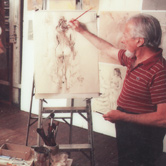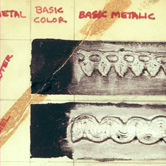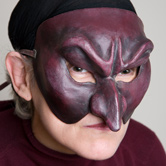Roots: Lester Polakov
For North American scenographers of my generation, it was as difficult to acquire an integrated education in scenography in theatre schools as it is now in film schools; certainly such a major was unavailable at the undergraduate level. And, individuals were entering graduate school as emerging scenographers without the necessary skill set with which to undertake ambitious thesis projects. Then, even more so than now, a serious candidate had to be willing to quilt together an adequate curriculum on their own and/or to travel long distances to find teachers, mentors and meaningful apprenticeship programmes.
The late Don Stowell made me aware of Lester Polakov’s Studio and Forum for Stage Design in New York City. Lester, having also noticed the shortfall, established his curriculum on the corner of Banks and Washington next door to Gothic Scene Paints in a corner property past Hell’s Kitchen. The exterior of Lester’s school looked like family photographs of the Occupation. For you see, seeking to balance the federal budget, Gerald Ford had let New York City go bankrupt.
I walked past HB Studio “twards da riva” as the locals advised. The theatre posters that lined the long stairwell reassured me only a little until I came upon smallish room with a smiling man at a simple desk. Lester Polakov told me he liked my work, especially the characters for The Red Balloon flying all over the unrolled, large sheet of drawing paper. And so, by the end of the interview, I was in. It was hard to believe that a hick from Tallahassee would be going to his school. Tuition was high: thank you, Papa. Double tuition: the home university’s and this rundown centre of scenography of the North-eastern United States. New York at that time cut through the pretension of flashy architecture and studio furniture. You had only an armature of what was needed; you shared; the classroom set up turned over from one subject to another through the labour of the students. The actual currency was talent: teacher or student. End of story. Tuition was non-refundable, but acceptance to the program was otherwise democratic. No marks, no attendance, no scenes. Slackers just died off and nobody cared. Lester tells his story in We Live to (Fly) Paint Again.
Richard Bernstein and Gordon Micunis were sincere and hard-working teachers. Bless Richard for his patience with the drafting. Somehow, ideas for costume proposals always emerged in the wee hours for Gordon’s class. I had to concede that despite my resistance the play scripts and directorial concepts he chose were better than I’d give them credit for. The crackling Fred, a Ukrainian Canadian, was a terrifying genius: a great artist and a great teacher. Lester’s wife was in my prop-making class. Regarding our productivity, she commented: “lest we incur the wrath of Fred…” It took some adjustment to ease from lavish regional facilities to the make-do environment.
It seemed embarrassing to be sculpting in the personal space Fred shared with Janet Harper: a one-room artist’s loft on Canal Street. Joke’s on me: my assistants also work in my house. Fred, the inventor of flexible armour for Patricia Zipprodt’s Pippin (1972), was shortly todesign the Garthim for Dark Crystal. At a time when his sexist colleagues in sculpture intimidated and belittled women, he celebrated and released the sculptor within me. I still love him for it, hard as I saw him be on others at times. He was a methodical, demanding and generous teacher. He ought not to have begrudged those whom he suspected of taking his courses [only] in order to enrich their own pedagogy in the provinces. I’m sure they mention you as often as I do, Fred. Such legacy is called transmission of mind.
^ back to top of the page

Polakov, Lester. We Live to (Fly) Paint Again. Logbooks Press, 1993. |

Sampler for Metalic Finishes, given by Frederick Nihda. Acrylic Paint. Graphite Powder. Lacquer. French Enamel Varnish. 1978. |

Mask Assignment: A study of emotion in the Commedia Style. Celastic, millinery wire, Koban thread, flexible spackle. white glue, acrylic paint. 1977. Photographed by Mina Momeni, 2012. |
References
- Personal Memories
- Polakov, Lester.
We Live to (Fly) Paint Again.
Logbooks Press, 1993.
- Stowell, Bambi.
“Annual [Costume Commission] Symposium”
USITT Newsletter. Ed. Herbert Gregg. Vol XIX, No. 4. (Sept/Oct. 1979). pp. 6-9.
^ back to top of the page
To Cite this Page
| CMS |
“Roots: Lester Polakov.” Valérie C. Kaelin Website; Scenography; Pedagogy; December 31, 2012. Accessed Month, Day, Year. http://www.valeriekaelin.com.
|
| MLA |
Kaelin, Valérie C., “Roots: Lester Polakov.” Toronto, 31 Dec. 2012. Web. Add Day, Abbreviation for Month, Year. |
|

